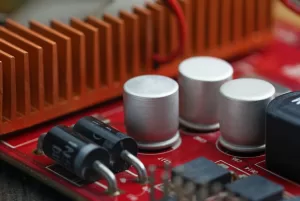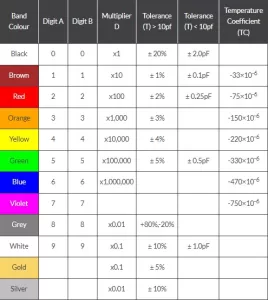
Ceramic Capacitors Basic: Definition, Characteristics and Applications
September 15 2023 
Inquiry
Global electronic component supplier AMPHEO PTY LTD: Rich inventory for one-stop shopping. Inquire easily, and receive fast, customized solutions and quotes.
QUICK RFQ
ADD TO RFQ LIST
Ceramic capacitors are one of the most commonly used types of capacitors in electronic circuits. They are known for their small size, high capacitance, and low cost, making them an attractive option for a wide range of applications. In this article, we will provide a basic overview of ceramic capacitors, including their definition, characteristics, and applications.
Capacitor Definition
A capacitor is an electronic component that stores and releases electrical energy. It consists of two conductive plates separated by an insulating material called a dielectric. When a voltage is applied across the plates, an electric field is created, causing a positive charge to accumulate on one plate and a negative charge on the other plate. The capacitor stores this charge, and the amount of charge it can store is determined by its capacitance value, measured in farads (F). For more information, please read this blog: Capacitor: Basic Concepts, Working, Types and Its ApplicationsWhat are Ceramic Capacitors?
Ceramic capacitors are a type of capacitor that uses a ceramic material as the dielectric. The dielectric is the insulating material between the two conductive plates of the capacitor. Ceramic capacitors are widely used in electronic circuits due to their compact size, high capacitance values, and good electrical performance.Characteristics of Ceramic Capacitors
Dielectric Material: Ceramic capacitors utilize various ceramic materials as the dielectric, such as ceramic compounds like barium titanate or titanium dioxide. These materials offer high dielectric constants, allowing for relatively high capacitance values in small physical sizes. Capacitance Range: Ceramic capacitors are available in a wide range of capacitance values, from picofarads (pF) to microfarads (μF) and beyond. They can provide high capacitance values even in small package sizes, making them suitable for compact electronic devices. Voltage Ratings: Ceramic capacitors come with different voltage ratings, indicating the maximum voltage they can withstand without risk of failure. It is important to choose a capacitor with a voltage rating higher than the expected voltage in the circuit to prevent breakdown or damage. Temperature Stability: Ceramic capacitors exhibit good temperature stability compared to some other capacitor types. However, their capacitance value can vary with temperature, which is specified by the capacitor manufacturer in terms of temperature coefficient. Capacitor Classes: Ceramic capacitors are categorized into classes based on their temperature coefficient and stability. The most common classes are Class 1 and Class 2. Class 1 capacitors have a low-temperature coefficient and high stability but generally have lower capacitance values. Class 2 capacitors have a higher temperature coefficient and are available in higher capacitance values. Surface Mount Technology (SMT): Ceramic capacitors are commonly available in surface-mount packages, which are suitable for automated assembly processes used in modern electronics manufacturing. They have become a popular choice for SMT applications due to their small size, reliability, and cost-effectiveness. Ceramic capacitors have a wide range of applications, including decoupling and bypassing in power supply circuits, filtering, timing, coupling, and voltage regulation in electronic devices and systems.Are Ceramic Capacitors Polarized?
No, ceramic capacitors are generally non-polarized, which means they can be connected to a circuit without regard to the polarity of the voltage applied to them. Unlike electrolytic capacitors, which are polarized and have specific positive and negative terminals, ceramic capacitors do not have polarity markings. This non-polarized characteristic of ceramic capacitors makes them versatile and allows for easy installation in circuits without worrying about the orientation. However, it's important to note that there are some specialized ceramic capacitors, such as tantalum ceramic capacitors, that can be polarized and have specific polarity markings. These polarized ceramic capacitors are less common and typically used in specific applications where polarity matters. In general, when using standard ceramic capacitors, you can connect them to a circuit in any orientation, and they will function properly regardless of the voltage direction.Multilayer Ceramic Capacitor
A multilayer ceramic capacitor (MLCC) is a type of ceramic capacitor that consists of multiple layers of ceramic material sandwiched between alternating layers of metal electrodes. The construction of MLCCs allows for high capacitance values in a compact form factor.
Tolerance and accuracy are precise
Ceramic capacitors are commonly used in electronics that require high stability and low loss. These instruments provide very accurate results, and their capacitance values are stable with respect to applied voltage, frequency, and temperature.Benefits of Small Size
When high component packing densities are necessary, these devices have a substantial advantage over standard capacitors.High voltage and high power
Ceramic capacitors are designed to resist higher voltages, and these capacitors are known as power ceramic capacitors. These capacitors are much larger than the PCBs. They also have specialized connections for safely connecting high-voltage supplies.Capacitor Color Code

Ceramic Capacitors vs Electrolytic Capacitors
Ceramic capacitors and electrolytic capacitors are two distinct types of capacitors, each with its own characteristics and applications. Here I list a chart to tell their differences.| Characteristic | Ceramic Capacitors | Electrolytic Capacitors |
| Dielectric Material | Ceramic material | Electrolyte (liquid or gel) |
| Capacitance Range | pF to μF | μF to F |
| Voltage Ratings | Low to moderate voltage | Higher voltage ratings |
| Polarization | Non-polarized | Polarized (positive and negative terminals) |
| Size and Packaging | Compact sizes, suitable for SMT | Larger in through-hole packages |
| Frequency Response | Excellent high-frequency response | Better for lower-frequency applications |
| Temperature Stability | Good temperature stability | More sensitive to temperature variations |
| Lifespan and Reliability | Longer lifespan, more reliable | Limited lifespan, may degrade over time |
How to Read A Ceramic Capacitor Value?
Polyester capacitors were once marked with a color code, which is no longer in use, but some capacitors may still be labeled this way. The code should be interpreted similarly to the resistor code, with the top three color bands indicating the capacitor's value in pF. Disregard the 4th and 5th bands, which denote tolerance and voltage rating, respectively. Reading the value of a ceramic capacitor requires understanding the alphanumeric markings typically found on the capacitor's body. The markings indicate the capacitance value, voltage rating, tolerance, and sometimes other specifications. Here's a general guide on how to read the value of a ceramic capacitor: Identify the capacitance value: The capacitance value is usually indicated by a three-digit or four-digit code. The most common coding schemes are as follows:- Three-digit code: The first two digits represent significant figures, and the third digit represents the number of zeros to add. For example, The "10" represents 10, and the "4" indicates four zeros, resulting in a capacitance of 100,000 pF or 100 nF.
- Four-digit code: The first three digits represent significant figures, and the last digit represents the multiplier. The multiplier indicates the number of zeros to add. For example, K: The "473" represents 47 and the "K" signifies adding three zeros, resulting in a capacitance of 47,000 pF or 47 nF.
What is A Ceramic Capacitor Used for?
Ceramic capacitors have a wide range of applications in electronic circuits due to their desirable electrical properties and compact size. Some common uses of ceramic capacitors: Decoupling and Bypassing: Ceramic capacitors are frequently used for decoupling and bypassing in power supply circuits. They help reduce noise and voltage fluctuations by providing a low-impedance path for high-frequency noise to bypass the power supply lines. Filtering: Ceramic capacitors are used in filtering applications to remove unwanted noise or high-frequency signals from a circuit. They can be employed in low-pass, high-pass, or band-pass filter configurations to shape the frequency response of a circuit. Timing and Oscillators: Ceramic capacitors are often used in timing circuits and oscillators to control the frequency and duration of signals. They are employed in conjunction with resistors and inductors to create precise timing components like RC (resistor-capacitor) and LC (inductor-capacitor) circuits. Coupling and DC Blocking: Ceramic capacitors are used for coupling or blocking direct current (DC) while allowing alternating current (AC) signals to pass through a circuit. They enable the transfer of AC signals between different stages of an amplifier or audio system. Voltage Regulation: Ceramic capacitors are employed in voltage regulation circuits to stabilize and smooth out voltage fluctuations. They can suppress high-frequency noise and provide transient response to maintain a steady voltage level. Snubber Circuits: Ceramic capacitors are utilized in snubber circuits to dampen or suppress voltage spikes and transient voltage pulses generated by inductive loads, such as motors or transformers. They protect sensitive components from voltage surges and help prevent damage. RF Applications: Ceramic capacitors find extensive use in radio frequency (RF) circuits and wireless communication devices. They are used for impedance matching, tuning, and resonant circuits in RF filters, antennas, and RF amplifiers. Sensor Applications: Ceramic capacitors are incorporated into various sensor applications, including temperature sensors, pressure sensors, and humidity sensors. They play a vital role in signal conditioning and filtering in these sensing systems. General Electronics: Ceramic capacitors are used in a wide range of electronic devices, such as computers, smartphones, televisions, audio equipment, and automotive electronics. They can be found in power supply circuits, signal processing circuits, timing circuits, and many other applications. Due to their versatility and broad range of capacitance values, ceramic capacitors are widely employed in numerous electronic circuits and systems, providing essential functions such as energy storage, signal conditioning, filtering, and timing.Conclusion
In conclusion, ceramic capacitors are widely used in electronic circuits due to their high capacitance, low cost, and small size. They have excellent stability, high reliability, and low losses, making them suitable for a wide range of applications such as decoupling, filtering, and timing. The characteristics of ceramic capacitors vary depending on the type of ceramic material used, and it is important to choose the right type for the specific application. Overall, ceramic capacitors are an essential component in modern electronics and will continue to play a crucial role in the development of new technologies. Capacitor DefinitionWhat are Ceramic Capacitors? Characteristics of Ceramic CapacitorsAre Ceramic Capacitors Polarized? Multilayer Ceramic CapacitorCapacitor Color CodeCeramic Capacitors vs Electrolytic CapacitorsHow to Read A Ceramic Capacitor Value? What is A Ceramic Capacitor Used for? Conclusion
Related Articles
Populer Posts
